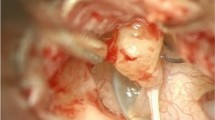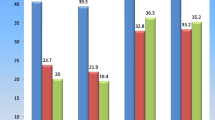Abstract
There is a correlation between macroscopic and histologic changes of incus in chronic otitis with cholesteatoma. The incidence and types of damage of auditory ossicles in chronic otitis media were extensively studied, but except some studies on reoperations there are no morphometric studies of human auditory ossicles in chronic otitis media. In order to define the rate of ossicular applicability for tympanoplasties in different macroscopic forms of damage, we analysed histologic changes of human incudes in correlation to their macroscopic alterations. Histomorphometric study of 82 intraoperatively removed human incudes, from chronic otitis media with cholesteatoma (attic, sinus, tensa cholesteatoma), was performed. They were divided according to the age of patients and localization of cholesteatoma. Erosions, vitality, vascular areas, osteomyelitic zones, and applicability of ossicles were measured. Progressive increase of erosions, decrease of vitality, dilatation of vascular spaces and osteomyelitic areas, and decrease of rate of potential applicability for tympanoplasties were found. Residual osteomyelitis was present in incudes with advanced external osteitis and ossicular defect. Macroscopic changes of incudes in cholesteatoma and their histologic structure correlate. Localisation of cholesteatoma is important for ossicular damage. Defects of long process with external osteitis of incudes and more intense pathological changes demand their removal and use of other reconstructive materials for tympanoplasties in order to avoid tympanoplasty failure.




Similar content being viewed by others
References
Lannigan FJ, O′Higgins P, McPhee P (1993) The cellular mechanism of ossicular erosion in chronic suppurative otitis media. J Laryngol Otol 107:12–16
Tos M (1979) Pathology of the ossicular chain in various chronic middle ear diseases. J Larygol Otol 93:769–780
Palva T (1988) Surgery related to histopathology in chronic inflammatory middle ear disease. J Laryngol Otol 102:851–856
Boyde A, Ali NN, Jones SJ (1985) Optical and scanning electron microscopy in the single osteoclast resorption assay. Scan Electron Microsc 3:1259–1271
Savic D, Herak R, Djeric D (1987) X-ray diffraction analysis of the auditory ossicles in chronic otitis. Acta Otolaryngol 104:125–129
Trinidad A, Ramirez-Camacho R, Garcia-Berrocal JR et al (2005) Pseudomonas aeruginosa infection in the hypoventilated middle ear: an experimental model. Acta Otolaryngol 125:266–269
Sade J, Berco E, Buyanover D, Brown M (1981) Ossicular damage in chronic middle ear inflammation. Acta Otolaryngol 92:273–283
Schuring AG, Lippy WH, Rizer FM, Schuring LT (1990) Staging for cholesteatoma in the child, and adult. Ann Otol Rhinol Laryngol 99:256–260
Tos M, Lau T (1989) Hearing after surgery for cholesteatoma using various techniques. Auris Nasus Larynx 16:61–73
Stankovic M (2005) Histomorphometric analysis of the structural changes of the incus and the results of cartilage ossiculoplasty in the attic cholestoma surgery. Mediterr J Otol 1:64–69
Siddiq MA, East DM (2004) Long-term hearing results of incus transposition. Clin Otolaryngol 29:115–118
Farrior JB, Nichols SW (1996) Long-term results using ossicular grafts. Am J Otol 17:386–392
Jeng FC, Tsai MH, Brown CJ (2003) Relationship of preoperative findings and ossicular discontinuity in chronic otitis media. Otol Neurotol 24:29–32
Miman MC, Cura O, Erdem T et al (2002) An important procedure in ossiculoplasty: autoclaving the ossicles. Rev Laryngol (Bord) 123:263–266
Ferekidis E, Nikolopoulos TP, Yiotakis J et al (2006) Should we use ossicular remnants in ossicular reconstruction following cholesteatoma removal? Otolaryngol Relat Spec 68:243–246
Jeng FC, Tsai MH, Brown CJ (2003) Relationship of preoperative findings and ossicular discontinuity in chronic otitis media. Otol Neurotol 24:29–32
Albu S, Babighian G, Trabalzini F (1998) Prognostic factors in tympanoplasty. Am J Otol 19:136–140
Yung M (2006) Long-term results of ossiculoplasty: reasons for surgical failure. Otol Neurotol 27:20–26
Ng SK, Yip WW et al (2003) Autograft ossiculoplasty in cholesteatoma surgery: is it feasible?. Laryngoscope 113:843–847
Frese KA, Hoppe F (1996) Morhologic studies of autologous and homologous ossicles after long-term implantation. Larynorhinootologie 75:330–334
Quaranta A, Bartoli R et al (1995) Cholesteatoma in children; histopathologic findings in middle ear ossicles. ORL J Otorhinolaryngol Relat Spec 57:296–298
Author information
Authors and Affiliations
Corresponding author
Rights and permissions
About this article
Cite this article
Stankovic, M. Applicability of autologous incus: the influence of age and localization of cholesteatoma. Eur Arch Otorhinolaryngol 264, 995–998 (2007). https://doi.org/10.1007/s00405-007-0293-1
Received:
Accepted:
Published:
Issue Date:
DOI: https://doi.org/10.1007/s00405-007-0293-1




